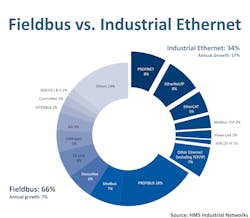Industrial network shares according to HMS
HMS Industrial Networks is an independent supplier of products and services for industrial communication. Their products enable industrial devices to connect to different industrial networks and HMS therefore has a substantial insight into the industrial network market. Here are some of the trends they see within industrial communication right now.
Both fieldbus and industrial Ethernet networks are growing, but Ethernet is growing faster
Looking at new installed nodes within factory automation globally, fieldbuses are still the most widely used type of network with 66% of the market. An interesting fact is that HMS sees fieldbuses still growing by approximately 7% per year. The main drivers for fieldbus growth is simplicity, tradition and reliability. The dominant fieldbus is PROFIBUS (18% of the total world market including industrial Ethernet) followed by Modbus (7%), DeviceNet (6%) and CC-Link (6%).
Industrial Ethernet networks make up for 34% of the market and are increasing faster than fieldbuses (17% per year), but HMS concludes that it will take some time before Industrial Ethernet outgrows fieldbuses. The main drivers for Ethernet growth are higher performance and office network integration. PROFINET and EtherNet/IP are the two biggest Ethernet networks with 8% of the total network market each. Runners-up are EtherCAT, Modbus-TCP and POWERLINK.
Regional variations
In Europe and the Middle East (EMEA), PROFIBUS is the dominant network while PROFINET has the fastest growth rate. Runners up are Modbus and EtherCAT.
The US market is dominated by the CIP networks where EtherNet/IP is overtaking DeviceNet in terms of market shares. Runners-up are PROFIBUS and EtherCAT. Furthermore, PROFINET gains market shares and Modbus is still popular.
In Asia, no network stands out as truly market-leading, but PROFIBUS, DeviceNet and Modbus are widely used. CC-Link is dominating in Japan, and EtherCAT is also gaining traction.
More and more devices are getting connected
“With more than 25 years of experience in industrial communication, we have a very good insight in the industrial network market,” says Anders Hansson, Marketing Director at HMS Industrial Networks. “The figures we present are based on insights from colleagues in the industry, our own sales statistics and overall perception of the market. On a general note, we see a shift towards industrial Ethernet but the migration to Industrial Ethernet is taking longer time than first expected. We still get a lot of requests for connectivity to both fieldbus and industrial Ethernet.”
Mr. Hansson continues: “What is completely evident, however, is that the network market remains fragmented and that industrial devices are getting more and more connected. This is accentuated by trends such as Industrial Internet of Things and Industry 4.0. With our long-term motto ‘Connecting Devices,’ HMS is well-suited to grow with these trends.”
>> For more information, click here

